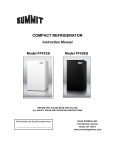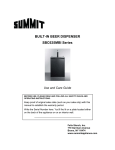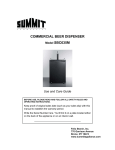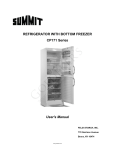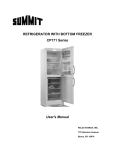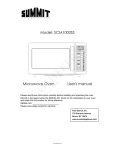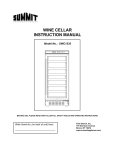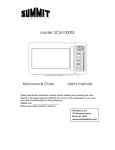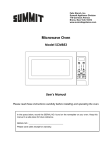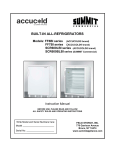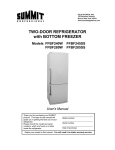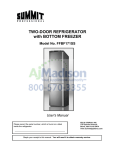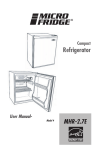Download two-door frost-free refrigerator / freezer
Transcript
FELIX STORCH, INC. 770 Garrison Avenue Bronx, New York 10474 www.summitappliance.com TWO-DOOR FROST-FREE REFRIGERATOR / FREEZER Models FF874 FF1074 FF1274 User's Manual Thank you for purchasing our SUMMIT product. This easy-to-use manual will guide you in getting the best use of your refrigerator. Please record the model and serial numbers, which are found on a label at the back of your appliance. _____________________________ Model number _____________________________ Serial number _____________________________ Date of purchase Staple your receipt to this manual. You will need it to obtain warranty service. IMPORTANT SAFEGUARDS Read all of the instructions before using this appliance. When using this appliance, always exercise basic safety precautions, including the following: 1. Use this appliance only for its intended purpose, as described in this User's Manual. 2. This refrigerator must be properly installed in accordance with the Installation instructions before it is used. See Grounding Instructions in the Installation section. 3. Never unplug your refrigerator by pulling on the power cord. Always grasp the plug firmly and pull straight out from the outlet. 4. Repair or replace immediately all electrical service cords that have become frayed or otherwise damaged. Do not use a cord that shows cracks or abrasion damage along its length or at the plug or connector end. 5. Unplug your refrigerator before cleaning or making any repairs. NOTE: If for any reason this product requires service, we strongly recommend that a certified technician perform the service. 6. Do not use any electrical device or any sharp instrument in defrosting your refrigerator. 7. If your old refrigerator is not being used, we recommend that you remove the doors and leave the shelves in place. This will reduce the possibility of danger to children. 8. After your refrigerator is in operation, do not touch the cold surfaces in the freezer compartment, particularly when hands are damp or wet. Skin may adhere to these extremely cold surfaces. 9. Do not refreeze foods which have been thawed completely. The United States Department of Agriculture in Home and Garden Bulletin No. 69 reads: "...You may safely refreeze frozen foods that have thawed if they still contain ice crystals or if they are still cold – below 40°F". "...Thawed ground meats, poultry or fish that have any off-odor or off-color should not be refrozen and should not be eaten. Thawed ice cream should be discarded. If the odor or color of any food is poor or questionable, discard it. The food may be dangerous to eat." "...Even partial thawing and re-freezing reduce the eating quality of foods, particularly fruits, vegetables and prepared foods. The eating quality of red meats is affected less than that of many other foods. Use refrozen foods as soon as possible, to save as much of their eating quality as you can." 10. This refrigerator should not be recessed or built into an enclosed cabinet. It is designed for freestanding installation only. 11. Do not operate your refrigerator in the presence of explosive fumes. 1 DANGER! Risk of child entrapment! Before you throw away your old refrigerator or freezer, take off the doors. Leave the shelves in place so that children may not easily climb inside. SAVE THESE INSTRUCTIONS for future use. 2 Table of Contents Important Safeguards ....................................................................................1 Parts and Features .........................................................................................4 Installation ......................................................................................................5 Unpacking Your Refrigerator .................................................................5 Adjusting Your Refrigerator ...................................................................5 Proper Air Circulation ............................................................................5 Electrical Requirements ........................................................................5 Installation Limitations ...........................................................................5 Door Alignment .....................................................................................6 Reversing the Door Swing .....................................................................7 Refrigerator Features and Use ......................................................................9 General Features ..................................................................................9 Refrigerator Interior Shelves .................................................................9 Crisper and Crisper Cover ...................................................................10 Food Storage Information ....................................................................11 Normal Operating Sounds ...................................................................12 Proper Refrigerator Care and Cleaning .....................................................13 Cleaning and Maintenance ..................................................................13 Light Bulb Replacement ......................................................................14 Power Interruptions .............................................................................14 Vacation and Moving Care ..................................................................14 Troubleshooting ...........................................................................................15 Warranty Information ...................................................................................16 3 Parts and Features 1. Ice cube tray 10. Freezer shelf 2. Full-width freezer door shelves 11. Gallon storage compartment 3. Door shelf 12. Can storage (not on all models) 4. Adjustable front leveling legs (not shown) 13. ½-width shelf storage compartment (not on all models) 5. Clear crisper 14. Full-width door shelf 6. Clear glass crisper cover 15. Crisper humidity control 7. Adjustable wire shelves (number varies by model) 16. Air flow control 8. Adjustable temperature control 17. Condiments storage shelf (FF1274 only) 9. Interior light 4 Installation Unpacking Your Refrigerator 1. Remove all packaging material. This includes the foam base and all adhesive tape holding the refrigerator accessories inside and out. Slide out and remove plastic or foam guard used to secure the compressor from shipping damage due to vibration and shock. 2. Inspect and remove any remains of packing, tape or printed materials before powering on the refrigerator. Adjusting Your Refrigerator Leveling Your Refrigerator: Your refrigerator has two leveling legs which are located in the front corners of the appliance. After properly placing your refrigerator in its final position, you can level the refrigerator. Leveling legs can be adjusted by turning them counterclockwise to raise the refrigerator or by turning them clockwise to lower it. The refrigerator door will close more easily when the leveling legs are raised. Proper Air Circulation To ensure that your refrigerator works at the maximum efficiency it was designed for, you should install it in a location where there are proper air circulation, plumbing and electrical connections. The following are recommended clearances around the refrigerator: Sides .................. 3/4" (19mm) Top ....................1" (25mm) Back ...................1" (25mm) Electrical Requirements Make sure there is a suitable power outlet (115V AC, 60Hz, 15 amps) with proper grounding to power the refrigerator. Avoid the use of three-prong adapters or cutting off the third grounding prong in order to accommodate a two-prong outlet. This is a dangerous practice since it provides no effective grounding for the refrigerator and may result in shock hazard. Installation Limitations Do not install your refrigerator in any location not properly insulated or heated, e.g., your garage, etc. Your refrigerator was not designed to operate in temperature settings below 55° Fahrenheit. 5 Select a suitable location for the refrigerator on a hard, even surface away from direct sunlight or heat source, e.g., radiators, baseboard heaters, cooking appliances, etc. Any floor unevenness should be corrected with the leveling legs located on the front bottom corners of the refrigerator. Door Alignment Freezer Door: (see Fig. #1) 1. Remove hinge cover screw. 2. Remove the top hinge cover. 3. Loosen the top hinge screws using a Phillips head screwdriver. Refrigerator Door: (see Fig. #2) 1. Loosen and remove the bottom hinge using a Phillips head screwdriver. 2. Adjust the door, or put a spacer between and then tighten the screws. 6 Reversing the Door Swing Left/right door opening method: This appliance allows you to reverse the door opening from left to right and back. You can select your preference of door opening by following the procedure to make the change. Dismantling: 1. Affix refrigerator and freezer doors by sticking adhesive tape on left and right sides to hold doors in place. 2. As shown in Fig. #1, dismantle the hinge box cover on the upper part of the freezer door with a Phillips head screwdriver. Then remove the three screws from the hinge. Take out the hinge by pulling it vertically, and keep it in a safe place. 3. Remove the adhesive tape on freezer door, left and take the door down, then carefully put it aside. 4. Dismantle two screws of the central hinge, left and take down the central hinge, and keep all pieces in a safe place. (see Fig. #3) 5. Remove the adhesive tape on refrigerator door, lift and take down refrigerator door, and carefully put it aside. 6. Remove the door stoppers from the freezer and refrigerator doors and install them on the opposite side of each door. (Not on all models) 7 Reinstallation: (See Figs. #4 and #5) 1. Remove the lower pivot pin from the bracket of the lower hinge by turning counter-clockwise. Move the pin to the opposite hole and tighten. 2. Loosen the screws holding the lower hinge bracket and remove the hinge. 3. Align the holes in the lower hinge bracket to the corresponding holes in the opposite side of the cabinet. Insert and tighten the screws. 4. To install refrigerator door, make the left bottom hole of the refrigerator compartment door fall over the lower hinge axle, move the door forward to make it straight and in alignment with the central hinge. Install the central hinge again turn the hinge axle until it completely enters the door body, then attach it with screws. 5. To install freezer door, make the left bottom hole of freezer door fall over the central hinge axle; raise upper hinge so that hinge axle can be installed in the upper hole of the upper part of the freezer door; adjust door to make it straight and level. 6. As shown in Fig. #1, install the upper freezer hinge to the left corresponding position. (Tighten the screws of the upper hinge.) 7. Replace the hinge cover as shown in Fig. #1. 8 Refrigerator Features and Use General Features Adjustable temperature dial: Your refrigerator will automatically maintain the temperature level you select. The temperature control dial has seven (7) settings plus OFF. 1 is the warmest. 7 is the coldest. Turning the dial to OFF stops cooling in both the refrigeration and freezer sections. At first, set the dial to 4 and allow 24 hours to pass before adjusting the temperature to your needs. To adjust the temperature range in the cold setting, turn the temperature dial in a clockwise direction. For normal operating conditions, keep the dial halfway between cold and coldest. For your convenience, the factory presets the control at normal operating conditions. (NOTE: If the refrigerator has been placed in a horizontal or tilted position for any period of time, wait 24 hours before plugging the unit in.) Refrigerator section interior light: Your refrigerator is equipped with an interior light in the fresh food section to help you locate your food more easily. Your freezer compartment is equipped with an adjustable airflow control. For your convenience, airflow is preset by the factory to the colder setting. There is also an option to adjust the settings, either to cold or coldest. Your refrigerator may be equipped with a slide control to raise or lower the humidity level in your crisper. This feature will increase the storage life of your fruits and vegetables. Simply adjust the control to the appropriate setting for the items you are storing in the crisper. Low settings allow moist air to exit the crisper, for optimum storage of fruit and/or vegetables that have skins. High settings retain moist air in the crisper, for optimum storage of fresh vegetables. Refrigerator Interior Shelves (Shelves may vary by model.) The refrigerator shelves were designed with you in mind. Their variable adjustability allows you to satisfy your personal storage needs. To remove or adjust a full-width slide-out shelf: (See Fig. #6) 1. Gently tilt the shelf up and slide it forward until the shelf has been completely removed. 2. To replace the shelf, select the desired setting and gently slide the shelf back until it rests in the locking position. 9 Crisper and Crisper Cover To remove and install the crisper: (See Fig. #7) 1. Grip the crisper firmly and slide out completely. 2. Replace the crisper by placing it properly in position and gently sliding it back into place. Removing or replacing the crisper cover: (See Fig. #8) 1. Carefully grasp the crisper cover and slide out to remove. 2. To replace, slide the rear of the crisper cover into the right and left slots above the crisper area and gently slide back into place. 10 Food Storage Information Fresh Food When storing fresh food that is not prepackaged, be sure to wrap or store it in airtight and moisture-proof material unless otherwise noted. This will ensure proper shelf life and prevent the transfer of odors and tastes. Wipe containers before storing to avoid needless messes. Eggs should be stored in an upright position in their original carton to maximize shelf life. Fruit should be washed and dried, then stored in sealed plastic bags before storing in the refrigerator. Vegetables with skins should be stored in plastic bags or containers. Leafy vegetables should be washed and dried, then stored in plastic bags or containers. Hot food should be allowed to cool before storing in the refrigerator. This will prevent unnecessary energy use. Fresh seafood should be used the same day as purchased. When storing meats in the fresh food section, keep in the original packaging or rewrap as necessary. Follow the suggestions below for safe storage: Chicken 1 - 2 days Ground beef 1 - 2 days Cold cuts 3 - 5 days Steaks/roasts 3 - 5 days Smoked/cured meats 7 - 10 days All others 1 - 2 days If longer periods of storage are required, store immediately in the freezer section. 11 Frozen Food Proper freezer storage requires correct packaging. All foods must be in packages that do not allow the flow of air or moisture in or out. Improper storage will result in odor and taste transfer and will result in the drying out of the improperly packaged food. Follow package or container instructions for proper storage. Packaging recommendations: Plastic containers with air-tight lids Heavy-duty aluminum foil Plastic wrap made from saran film Self-sealing plastic bags. Do not refreeze defrosted/thawed foods. It is recommended that the freezing date be marked on the packaging. Normal Operating Sounds Your May Hear The fan circulating air inside the interior of your unit to maintain the temperature you have selected. Boiling water, gurgling sounds or slight vibrations that are the result of the refrigerant circulating through the cooling coils. The thermostat control clicking when it cycles on and off. 12 Proper Refrigerator Care and Cleaning Cleaning and Maintenance Warning: To avoid electric shock, always unplug your refrigerator before cleaning. Ignoring this warning may result in death or injury. Caution: Before using cleaning products, always read and follow manufacturer's instructions and warnings to avoid personal injury or product damage. General: Prepare a cleaning solution of 3-4 tablespoons of baking soda mixed with warm water. Use a sponge or soft cloth dampened with the cleaning solution to wipe down your refrigerator. Rinse with clean warm water and dry with a soft cloth. Do not use harsh chemicals, abrasives, ammonia, chlorine bleach, concentrated detergents, solvents or metal scouring pads. Some of these chemicals may dissolve, damage and/or discolor your refrigerator. Door Gaskets: Clean door gaskets every three months according to general instructions. Gaskets must be kept clean and pliable to ensure a proper seal. Petroleum jelly applied lightly on the hinge side of gaskets will keep the gasket pliable and ensure a good seal. For refrigerator models FF874, FF1074 and FF1274, we recommend that you clean the rear of the refrigerator at least twice a year. Some operating environments may require more frequent cleaning. Slowly pull the refrigerator straight out away from the wall. NOTE: Do not move the refrigerator sideways as this may cause damage to the floor covering below the refrigerator. Unplug the refrigerator. Use a vacuum or a brush to clean coils. When cleaning has been completed, plug the cord back into the outlet and slide the refrigerator straight back to its original position. NOTE: When pushing it back, be sure not to roll over the power cord. 13 Light Bulb Replacement 1. 2. 3. 4. 5. 6. 7. 8. Switch off power to refrigerator. Remove the highest shelf. Allow light bulb to cool before removing. Pinch the plastic cover between fingers and thumb and gently pull to the left. Remove the bulb by screwing it counter-clockwise. Always replace with an appliance-type light bulb rated at 15 watts or less. Do not exceed the 15-watt rating at any time. To replace cover, insert rear clips first and gently push front clip in until the cover snaps into place. Power Interruptions Occasionally there may be power interruptions due to thunderstorms or other causes. Remove the power cord from AC outlet when a power outage occurs. When power has been restored, replug power cord into AC outlet. If outage is for a prolonged period, inspect and discard spoiled or thawed food in refrigerator and freezer. Clean refrigerator before using. Vacation and Moving Care For long vacations or absences, empty food from refrigerator and freezer, move the temperature dial to OFF and clean the refrigerator, freezer and door gaskets according to the General instructions on page 13. Prop doors open so air can circulate inside. When transporting the unit, always move it in a vertical position. Do not move the unit in a horizontal position. Possible damage to the sealed system could occur. 14 Troubleshooting Refrigerator does not operate Check that thermostat control is not in the OFF position. Check that refrigerator is plugged in. Check if there is power at the AC outlet by inspecting the fuse or circuit breaker. Food temperature appears too warm There may have been frequent door openings. Allow time for recently added warm food to reach fresh food or freezer temperature. Check gaskets for proper seal. Adjust temperature control to colder setting. Food temperature is too cold If temperature control setting is too cold, adjust to a warmer setting and allow several hours for temperature to adjust. Refrigerator runs too frequently This may be normal to maintain constant temperature during days of high temperature and humidity. Doors may have been opened frequently or left open for an extended period of time. Check gasket for proper seal. Check to see if doors are completely closed. Moisture build-up on interior or exterior of the refrigerator This is normal during high humidity periods. Prolonged or frequent door openings. Check door gaskets for proper seal. Refrigerator has an odor Interior needs cleaning. Foods improperly wrapped or sealed are giving off odors. Refrigerator light does not work Check power supply. Tighten bulb in socket. Replace burned-out bulb. Refrigerator/Freezer door does not shut properly Level the refrigerator. Realign refrigerator/freezer door. Check for blockages, e.g., food containers, crisper cover, shelves, bins, etc. 15 Limited Warranty PARTS AND LABOR WARRANTY INFORMATION SUMMIT Appliances are manufactured to provide outstanding value, and your satisfaction is our goal on every product. All SUMMIT major appliances carry a one year limited warranty on both parts and labor. All refrigerators and freezers carry an additional four years on the compressor. Certain exclusions may apply. Certain models (including SUMMIT ranges, wall ovens, and cook tops) are manufactured for us in the U.S. and carry the manufacturer's warranty (also one year parts and on-site labor). For details on specific warranty issues, please refer to the warranty packed with the product, or contact us. GENERAL PARTS AND LABOR WARRANTY Summit warrants, to the original purchaser of every new unit, the cabinet and all parts thereof, to be free from defects in material or workmanship, under normal and proper use and maintenance service as specified by Summit and upon proper installation and start-up in accordance with the instruction packet supplied with each Summit unit. Summit’s obligation under this warranty is limited to a period of 12 months from the date of original purchase. Any parts covered under this warranty that are determined by Summit to have been defective, within the above said period, are limited to the repair or replacement, including labor charges, of defective parts or assemblies. The labor warranty shall include pre-approved standard straight time labor charges only and reasonable travel time, as determined by Summit. COMPRESSOR WARRANTY In addition to the warranty period stated above, Summit warrants its hermetically sealed compressor to be free from defects in both material and workmanship, under normal and proper use and maintenance, for a period of 60 months from the date of original purchase. Compressors determined by Summit to have been defective within this extended time period will, at Summit’s option, be either repaired or replaced with a compressor or compressor parts of similar design and capacity. The above said extended compressor warranty applies only to hermetically sealed parts of the compressor and DOES NOT apply to any other parts or components, including, but not limited to, cabinet, paint finish, temperature control, refrigerant, metering device, driers, motor starting equipment, fan assembly, or any other electrical component, etc. WARRANTY CLAIMS All claims for labor or parts must be made directly through Summit. All claims should include: model number of the unit, the serial number of the cabinet, proof of purchase, date of installation, and all pertinent information supporting the existence of the alleged defect. In case of compressor warranty, the compressor model tag must be returned to Summit along with the above listed information. All claims should be filed within 30 days of completed repair or the warranty claim could be refused. THINGS NOT COVERED BY THIS WARRANTY Summit’s sole obligation under this warranty is limited to either repair or replacement of parts, subject to the additional limitations below. This warranty neither assumes nor authorizes any person to assume obligations other than those expressly covered by this warranty. NO CONSEQUENTIAL DAMAGES: Summit is not responsible for economic loss; profit loss; or special, direct, indirect, or consequential damages, including without limitation, losses or damages arising from food or product spoilage claims whether or not on account of refrigeration failure. WARRANTY IS NOT TRANSFERRABLE: This warranty is not assignable and applies only in favor of the original purchaser/user to whom delivered. Any such assignment or transfer shall 16 IMPROPER USE: Summit assumes no liability for parts or labor coverage for component failure or other damages resulting from improper usage or installation or failure to clean and/or maintain product as set forth in the warranty packet provided with the unit. ALTERATION, NEGLECT, ABUSE, MISUSE, ACCIDENT, DAMAGE DURING TRANSIT OR INSTALLATION, FIRE, FLOOD, ACTS OF GOD: Summit is not responsible for the repair or replacement of any parts that Summit determines have been subjected after the date of manufacture to alteration, neglect, abuse, misuse, accident, damage during transit or installation, fire, flood, or act of God. IMPROPER ELECTRICAL CONNECTIONS: Summit is not responsible for the repair or replacement of failed or damaged components resulting from electrical power failure, the use of extension cords, low voltage, or voltage drops to the unit. NO IMPLIED WARRANTY OF MERCHANTABILITY OR FITNESS FOR A PARTICULAR PURPOSE: There are no other warranties, expressed, implied or statutory, except the parts & labor warranty and the extended compressor warranty specifically described above. These warranties are exclusive and in lieu of all other warranties, including implied warranty and merchantability or fitness for a particular purpose. There are no other warranties which extend beyond the description on the face hereof. OUTSIDE CONTIGUOUS UNITED STATES: This warranty does not apply to, and Summit is not responsible for, any warranty claims made on products sold or used outside the Contiguous (48) United States. To be clear, this warranty excludes the states of Alaska and Hawaii and all off-shore territories. REQUESTING SERVICE If you are in need of service, please either fill out a service request on our website, http://www.summitappliance.com/support, or call us at 800-932-4267 or 718-893-3900. Please be prepared to give us the following information: your name, address, phone, email, model, serial, date of purchase, place of purchase, and the problem you are having. 17



















